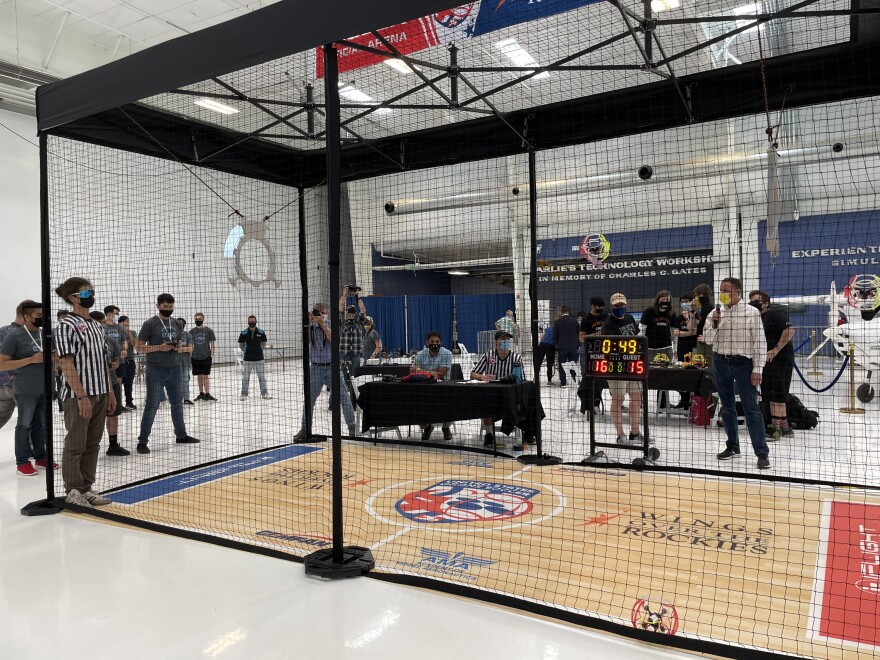On May 1, Wings Over the Rockies: Exploration of Flight in Englewood hosted a unique, esport competition — U.S. Drone Soccer’s first academic tournament in North America.
Four schools competed in the inaugural event, including Westminster High School. While the large hall buzzed with pregame activities, like labeling batteries and calibrating and testing the drones, sophomore Khang Tran was already hyping up his nine-person team.
“Today, we’re here to win right? Right,” he said. “Make sure you got your A game ready.”
Drone soccer is played indoors in an enclosed 10x10x20-foot netted arena. The players stand outside the boundaries and pilot remote-controlled hobby quadcopters enclosed in protective plastic spheres, which create small soccer balls.
The goals are vertical hoops located on opposing ends of the court. A team scores one point when the striker flies their drone through the hoop.
The sport looks a lot like Quidditch, the game that originated in the Harry Potter books, according to Major Kyle Sanders, a co-founder of U.S. Drone Soccer.
The event is a round-robin tournament, and each team has three players: one striker and two goalies. Westminster faced off against Colorado Spring’s Coronado High School in the first match. Each match has three 3-minute rounds.
Sanders is the tournament announcer.
“All right, both teams arm your drones,” he said. “Ready, three, two, one.”
The drones buzz loudly as they quickly zip through the air. Westminster’s are painted teal and black, the school colors. The striker drones have two pieces of tape hanging from them to avoid confusion.
“They got two for Westminster, one for Coronado,” Sanders calls out.
Drone soccer was introduced in South Korea in 2016 and has spread to other countries. Here in the U.S., the sport is designed to be both fun and educational.
The U.S. Drone Soccer program is designed for sixth through 12th grade students. The curriculum is a perfect for teaching, said Sanders, because it “takes robotics and moves it into a whole new dimension.”
“The goal is to show them future career paths,” he said. “If we can get them excited with the game, they’re going to build and program the drones and not realize that those skills can immediately go into an aerospace career that even in high school, they can get paid to do this."
According to the Federal Aviation Administration, 16-year-olds can get a drone pilot certificate. Drone pilot jobs include filming video, surveying land and search and rescue. The average pay for a beginner pilot is almost $40 an hour.
The organization decided to first do intensive focus testing in Colorado, which is home to many aerospace companies, before making the program available nationally.

The week before the tournament, Tran is in the Aerospace Engineering class at Westminster High School. The sophomore loves to solve problems and is rummaging through a plastic bin looking for screws to fix a drone.
“Here we are, here’s one of them, just need one more now,” he said. “Here’s the other, cool.”
Drone soccer is technically an after-school program at the high school, but teacher Robbie Ferguson decided to introduce it during his aerospace engineering class as an extension activity. He wants to get the students excited about drones.
“I’m going to give you guys the flight log,” he said while handing each student a sheet of paper.
The school purchased the U.S. Drone Soccer curriculum, which provides equipment, training and lesson plans. The students build, operate and learn how to fly the drones.
Today, they are doing maintenance.
“I’ve noticed a lot of the screws are missing,” Ferguson said. “Let’s go ahead and maintain them, program them today, make sure you’re filing out that flight log.”
The students will also learn to code by programming the drones using an open-source software. The drones are fully customizable.
“If they’ve been flying for a while, they can actually adjust the settings so that it’s a lot more aggressive and they’re a lot faster than the other ones,” he said. “But right now, since this is all brand new to all of them, we’ve kind of scaled it back.”

Back at the competition, it is the second round and Westminster has swapped out players. Three new students man the drones, including Tran, the striker.
Westminster’s black and teal drones bobbed, weaved and flew around rapidly. The defenders blocked the opposing striker and Tran scored multiple times.
“Westminster is ahead by one,” Sanders announced.
When the round was over, they had the lead.
But in the third round, Westminster’s drones had calibration issues and the team ended up losing it and the match. The school went on to play two more games and finished the tournament in third place.
But Tran still had a great time and hopes to play again next school year.
“Wow, that was incredible,” he said. “We were so close, but we all did really great, especially for the amount of experience we’ve had.”
Ferguson, who coached the team, echoed Tran's sentiments.
“I’m super happy, we still did really wonderful. I’m proud of my kiddos.”



